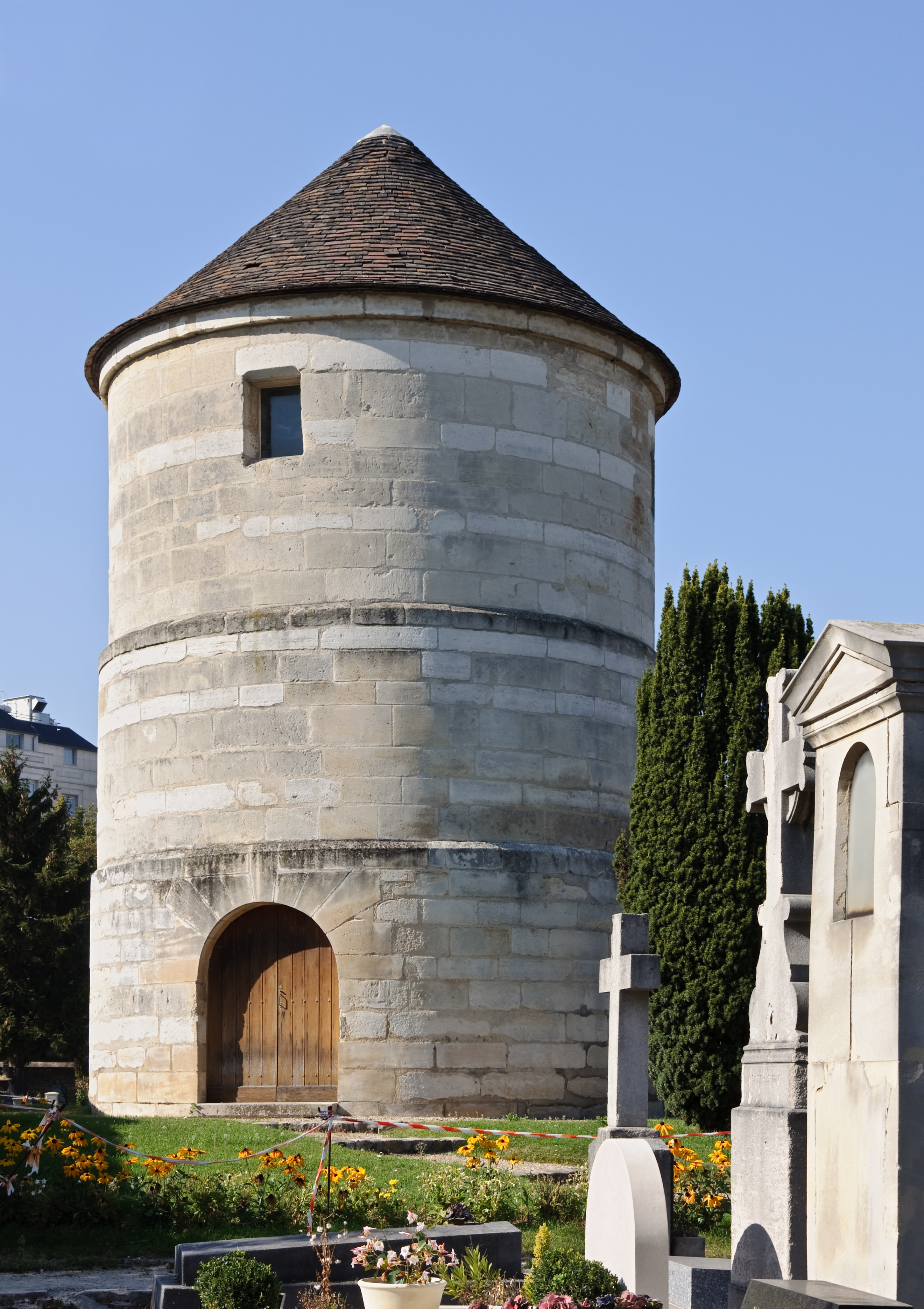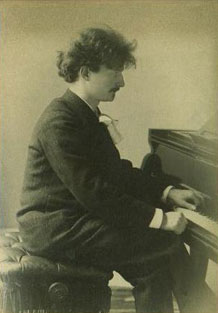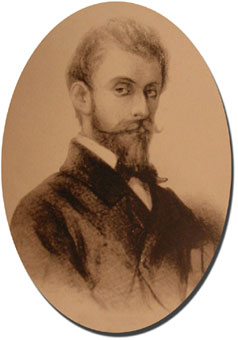|
Auguste Toulmouche
Auguste Toulmouche (21 September 1829 – 16 October 1890) was a French painter known for his luxurious genre paintings of upper middle class Parisian women in domestic scenes. Biography Auguste Toulmouche was born in Nantes to Émile Toulmouche, a well-to-do broker, and Rose Sophie Mercier. He studied drawing and sculpture locally with the sculptor Amédée Ménard and painting with the portraitist Biron before moving to Paris in 1846 to study with the painter Charles Gleyre. He was said to be one of Gleyre's favored students, and he exhibited his first paintings at the Paris Salon in 1848 when he was just 19. He exhibited again in 1849 and 1850, at which time he was specializing in portraits. Toulmouche painted in an idealizing version of the dominant academic realist style, and his subjects were frequently Parisian women who belonged to the upper bourgeoisie. His work was popular in both France and America, and the emperor Napoleon III bought one of his paintings, ''La fi ... [...More Info...] [...Related Items...] OR: [Wikipedia] [Google] [Baidu] |
Jean-Louis Hamon
Jean-Louis Hamon (5 May 1821 – 29 May 1874) was a French painter. Hamon was born at Plouha, in today's Côtes-d'Armor ''département'', in France. At an early age he was intended for the priesthood, and placed under the care of the brothers Lamennais, but his strong desire to become a painter finally triumphed over family opposition, and in 1840 he left Plouha for Paris—his sole resources being a pension of five hundred francs, granted him for one year only by the municipality of his native town. At Paris Hamon received valuable advice and encouragement from Paul Delaroche and Charles Gleyre, and in 1848 he made his debut at the Salon with ''Le Tombeau du Christ'' (Musée de Marseille), and a decorative work, ''Dessus de Porte.'' The works which he exhibited in 1849, ''Une Affiche romaine'', ''L'Égalité au sérail'', and ''Perroquet jasant avec deux jeunes filles'', obtained no marked success. His lack of success led Hamon to accept a job as a designree in the Sè ... [...More Info...] [...Related Items...] OR: [Wikipedia] [Google] [Baidu] |
19th-century French Painters
The 19th (nineteenth) century began on 1 January 1801 ( MDCCCI), and ended on 31 December 1900 ( MCM). The 19th century was the ninth century of the 2nd millennium. The 19th century was characterized by vast social upheaval. Slavery was abolished in much of Europe and the Americas. The First Industrial Revolution, though it began in the late 18th century, expanding beyond its British homeland for the first time during this century, particularly remaking the economies and societies of the Low Countries, the Rhineland, Northern Italy, and the Northeastern United States. A few decades later, the Second Industrial Revolution led to ever more massive urbanization and much higher levels of productivity, profit, and prosperity, a pattern that continued into the 20th century. The Islamic gunpowder empires fell into decline and European imperialism brought much of South Asia, Southeast Asia, and almost all of Africa under colonial rule. It was also marked by the collapse of the large S ... [...More Info...] [...Related Items...] OR: [Wikipedia] [Google] [Baidu] |
Sterling And Francine Clark Art Institute
The Sterling and Francine Clark Art Institute, commonly referred to as the Clark, is an art museum and research institution located in Williamstown, Massachusetts, United States. Its collection consists of European and American paintings, sculpture, prints, drawings, photographs, and decorative arts from the fourteenth to the early twentieth century. The Clark, along with the Massachusetts Museum of Contemporary Art (MASS MoCA) and the Williams College Museum of Art (WCMA), forms a trio of art museums in the Berkshires. The institute also serves as a center for research and higher learning. It is home to various research and academic programs, which include the Fellowship Program and the Williams College Graduate Program in the History of Art. It is visited by 200,000 people a year. History Origins "The Clark" was created in 1955 in association with Williams College by entrepreneur, soldier, explorer, and prominent art collector Robert Sterling Clark, and his wife, Francine. Aft ... [...More Info...] [...Related Items...] OR: [Wikipedia] [Google] [Baidu] |
Museum Of Fine Arts, Boston
The Museum of Fine Arts (often abbreviated as MFA Boston or MFA) is an art museum in Boston, Massachusetts. It is the 20th-largest art museum in the world, measured by public gallery area. It contains 8,161 paintings and more than 450,000 works of art, making it one of the most comprehensive collections in the Americas. With more than 1.2 million visitors a year, it is the 52nd–most visited art museum in the world . Founded in 1870 in Copley Square, the museum moved to its current Fenway location in 1909. It is affiliated with the School of the Museum of Fine Arts at Tufts. History 1870–1907 The Museum of Fine Arts was founded in 1870 and was initially located on the top floor of the Boston Athenaeum. Most of its initial collection came from the Athenæum's Art Gallery. Francis Davis Millet, a local artist, was instrumental in starting the art school affiliated with the museum, and in appointing Emil Otto Grundmann as its first director. In 1876, the museum moved to a h ... [...More Info...] [...Related Items...] OR: [Wikipedia] [Google] [Baidu] |
Louvre
The Louvre ( ), or the Louvre Museum ( ), is the world's most-visited museum, and an historic landmark in Paris, France. It is the home of some of the best-known works of art, including the ''Mona Lisa'' and the ''Venus de Milo''. A central landmark of the city, it is located on the Right Bank of the Seine in the city's 1st arrondissement (district or ward). At any given point in time, approximately 38,000 objects from prehistory to the 21st century are being exhibited over an area of 72,735 square meters (782,910 square feet). Attendance in 2021 was 2.8 million due to the COVID-19 pandemic, up five percent from 2020, but far below pre-COVID attendance. Nonetheless, the Louvre still topped the list of most-visited art museums in the world in 2021."The Art Newspaper", 30 March 2021. The museum is housed in the Louvre Palace, originally built in the late 12th to 13th century under Philip II. Remnants of the Medieval Louvre fortress are visible in the basement ... [...More Info...] [...Related Items...] OR: [Wikipedia] [Google] [Baidu] |
Montparnasse Cemetery
Montparnasse Cemetery (french: link=no, Cimetière du Montparnasse) is a cemetery in the Montparnasse quarter of Paris, in the city's 14th arrondissement. The cemetery is roughly 47 acres and is the second largest cemetery in Paris. The cemetery has over 35,000 graves and approximately a thousand people are buried here each year. The cemetery contains 35,000 plots and is the resting place to a variety of individuals including political figures, philosophers, artists, actors, and writers. Additionally, in the cemetery one can find a number of tombs commemorating those who died in the Franco-Prussian war during the siege of Paris (1870–1871) and the Paris Commune (1871). History The cemetery was created at the beginning of the 19th century in the southern part of the city. At the same time there were cemeteries outside the city limits: Passy Cemetery to the west, Montmartre Cemetery to the north, and Père Lachaise Cemetery to the east. In the 16th century the intersecting road ... [...More Info...] [...Related Items...] OR: [Wikipedia] [Google] [Baidu] |
Syncope (medicine)
Syncope, commonly known as fainting, or passing out, is a loss of consciousness and muscle strength characterized by a fast onset, short duration, and spontaneous recovery. It is caused by a decrease in blood flow to the brain, typically from low blood pressure. There are sometimes symptoms before the loss of consciousness such as lightheadedness, sweating, pale skin, blurred vision, nausea, vomiting, or feeling warm. Syncope may also be associated with a short episode of muscle twitching. Psychiatric causes can also be determined when a patient experiences fear, anxiety, or panic; particularly before a stressful event usually medical in nature. When consciousness and muscle strength are not completely lost, it is called presyncope. It is recommended that presyncope be treated the same as syncope. Causes range from non-serious to potentially fatal. There are three broad categories of causes: heart or blood vessel related; reflex, also known as neurally mediated; and orthos ... [...More Info...] [...Related Items...] OR: [Wikipedia] [Google] [Baidu] |
Ignacy Jan Paderewski
Ignacy Jan Paderewski (; – 29 June 1941) was a Polish pianist and composer who became a spokesman for Polish independence. In 1919, he was the new nation's Prime Minister and foreign minister during which he signed the Treaty of Versailles, which ended World War I. A favorite of concert audiences around the world, his musical fame opened access to diplomacy and the media, as possibly did his status as a freemason, and charitable work of his second wife, Helena Paderewska. During World War I, Paderewski advocated an independent Poland, including by touring the United States, where he met with President Woodrow Wilson, who came to support the creation of an independent Poland in his Fourteen Points at the Paris Peace Conference in 1919, which led to the Treaty of Versailles.Hanna Marczewska-Zagdanska, and Janina Dorosz, "Wilson – Paderewski – Masaryk: Their Visions of Independence and Conceptions of how to Organize Europe," ''Acta Poloniae Historica'' (1996), Issue 73, ... [...More Info...] [...Related Items...] OR: [Wikipedia] [Google] [Baidu] |
Ernest Reyer
Louis Étienne Ernest Reyer (1 December 1823 – 15 January 1909) was a French opera composer and music critic. Biography Ernest Reyer was born in Marseille. His father, a notary, did not want his son to take up a career in music. However, he did not actively block his son's ambitions and allowed him to attend classes at the Conservatoire from age six to sixteen. In 1839, when he was 16 years old, Ernest traveled to north Africa to work under his brother-in-law, head of accounting for the Treasury Department in Algeria. The job was not a good fit with Reyer's nonchalant and undisciplined temperament. From administrative documents, it is apparent that Reyer wrote innumerable youthful essays and stories, and original dance pieces. Some of his early compositions achieved local notoriety and received favorable comments in the Algerian press, including a Mass performed at the cathedral that was performed for the arrival of the Duke of Aumale in 1847. Reyer returned to Paris during th ... [...More Info...] [...Related Items...] OR: [Wikipedia] [Google] [Baidu] |
Elie Delaunay
Elie and Earlsferry is a coastal town and former royal burgh in Fife, and parish, Scotland, situated within the East Neuk beside Chapel Ness on the north coast of the Firth of Forth, eight miles east of Leven. The burgh comprised the linked villages of Elie ( ) to the east and to the west Earlsferry, which were formally merged in 1930 by the Local Government (Scotland) Act 1929. To the north is the village of Kilconquhar and Kilconquhar Loch. The civil parish has a population of 861 (in 2011).Census of Scotland 2011, Table KS101SC – Usually Resident Population, publ. by National Records of Scotland. Web site http://www.scotlandscensus.gov.uk/ retrieved March 2016. See "Standard Outputs", Table KS101SC, Area type: Civil Parish 1930 Ancient times Earlsferry, the older of the two villages, was first settled in time immemorial . It is said that MacDuff, the Earl of Fife, crossed the Forth here in 1054 while fleeing from King Macbeth. In particular the legend tells of his e ... [...More Info...] [...Related Items...] OR: [Wikipedia] [Google] [Baidu] |
Paul Baudry
Paul may refer to: *Paul (given name), a given name (includes a list of people with that name) *Paul (surname), a list of people People Christianity *Paul the Apostle (AD c.5–c.64/65), also known as Saul of Tarsus or Saint Paul, early Christian missionary and writer *Pope Paul (other), multiple Popes of the Roman Catholic Church *Saint Paul (other), multiple other people and locations named "Saint Paul" Roman and Byzantine empire *Lucius Aemilius Paullus Macedonicus (c. 229 BC – 160 BC), Roman general *Julius Paulus Prudentissimus (), Roman jurist *Paulus Catena (died 362), Roman notary *Paulus Alexandrinus (4th century), Hellenistic astrologer *Paul of Aegina or Paulus Aegineta (625–690), Greek surgeon Royals *Paul I of Russia (1754–1801), Tsar of Russia *Paul of Greece (1901–1964), King of Greece Other people *Paul the Deacon or Paulus Diaconus (c. 720 – c. 799), Italian Benedictine monk *Paul (father of Maurice), the father of Maurice, Byzan ... [...More Info...] [...Related Items...] OR: [Wikipedia] [Google] [Baidu] |

%2C_French_painter%2C_published_in_journal_in_1888.jpg)








_(cropped).jpg)